Weimar
![]()
The title of this article is ambiguous. For other meanings, see Weimar (disambiguation).
Weimar is an independent city in Thuringia in Germany, known for its cultural heritage. The medium-sized city is located on an arc of the Ilm River southeast of the Ettersberg Mountain, the highest mountain in the Thuringian Basin at 478 metres. The city is the fourth largest in Thuringia after Erfurt, Jena and Gera and is located about halfway between Erfurt to the west and Jena to the east.
Weimar is a medium-sized centre that fulfils partial functions of a regional centre and has called itself a university city since 2004. In addition to the Bauhaus University, the city is home to the Franz Liszt Academy of Music and the Duchess Anna Amalia Library, as well as authorities such as the Thuringian Higher Administrative Court, the Thuringian State Administrative Office, the Thuringian Constitutional Court and the Thuringian State Office for the Preservation of Historical Monuments and Archaeology.
In the 16th century, the painters Lucas Cranach the Elder and the Younger were active in Weimar. In the 17th century the Fruchtbringende Gesellschaft was founded. The stays of Johann Sebastian Bach fall into the 18th century. This is followed by the Weimar Classicism with Wieland, Goethe, Herder and Schiller. The 19th century is associated with Franz Liszt, Richard Strauss, Friedrich Nietzsche and the landscape painters of the Weimar School of Painting at the Grand Ducal Saxon School of Art. At the beginning of the 20th century, Harry Graf Kessler and Henry van de Velde worked in Weimar and the founding of the Bauhaus and the Weimar Republic followed.
UNESCO declared the Bauhaus sites in Weimar and Dessau a World Heritage Site in 1996 and "Classical Weimar" in December 1998. In addition, Goethe's estate, which is kept in the Goethe and Schiller Archive in Weimar, was included by UNESCO in the cultural memory of humanity as a World Documentary Heritage (Memory of the World) in 2001. Since 2015, the World Documentary Heritage has also included early writings of the Reformation, some of which are kept in the Herzogin Anna Amalia Library in Weimar. The cultural heritage of national and international standing is presented in over 25 museums and exhibition venues.
Weimar was since 1547/52 capital and residence of the Duchy of Saxony or Saxony-Weimar, later Saxony-Weimar-Eisenach (since 1815: Grand Duchy). In 1816 this became the first state in Germany to give itself a constitution. Parallel to the meeting of the National Assembly from 6 February 1919 to September 1919, Weimar was temporarily the seat of government of the constituent Weimar Republic. From 1920 to 1952, Weimar was the capital of the state of Thuringia. In 1999 it was the European Capital of Culture.

City hall of the city (2006)
History
Previous story
In Ehringsdorf, a district in the southeast of Weimar, the skeleton of the Ehringsdorf prehistoric man was found in 1925, whose age is estimated at about 200,000 to 250,000 years. These are the fossil remains of a woman of about 20 to 30 years of age. Human skull bones had already been discovered in the same quarry in 1908.
In 1850, a large, badly worn copper cauldron, which had been repaired several times, was found about 6 m deep in a peat ditch near Possendorf. Seven vessels were arranged around it. There was also an anthropomorphic wooden figure with its arms inserted. Nearby, a large oak tree was found with a human skeleton. The cauldron is dated to between the 4th and 1st centuries BC, and the only surviving clay vessel is placed around the turn of the 2nd and 1st centuries. There is no evidence of prolonged use of the site. It could be a ritual burial of cult utensils.
Medieval
The oldest records of Weimar date back to the year 899. The name goes back to the Old High German or Old Saxon words wīh for "sanctuary, temple" and mer, meri for "lake, sea" and thus originally meant "sanctuary lake". Early surviving forms are "actum Wimares" ([9th century] 1150/65), "in Wimeri" ([984] 1012/18), "de Wimari" (1123/37), "Wymar" (1506), and finally "Weimar" (1556).
Between 946 and 1346, the county of Weimar (later known as the county of Weimar-Orlamünde) existed as an independent political entity. Emperor Otto II mentioned the settlement of Weimar Castle on a document issued to the monastery of Fulda on 3 June 975; this is regarded as the "birth certificate of the town", although it is not entirely certain whether "Wimares" really means the present town. It could also have meant the town of Wechmar, which fits much better into Otto's presumed itinerary. What is certain, however, is that although the castle was by no means a stone fortification, but only a rampart with palisades, it must have been relatively secure. Both the troops of King Otto III, who in 984 harassed Count Wilhelm II of the Weimar noble family in his castle, and in 1002 the Ekkehardins, who were fighting for supremacy in Thuringia, had to give up the siege without success. It was destroyed in the winter of 1173/74 by Landgrave Ludwig III of the House of Ludowingen, who in the meantime had risen to territorial power in Thuringia. However, it was quickly rebuilt, for in 1214 there was another siege of the complex, this time expressly designated as castrum Wimar.
In 1250 there is also the first mention of a settlement, which, however, must have formed earlier under the protection of the castle. The later town church was built between 1245 and 1249 and consecrated to St. Peter the Apostle in 1254 at the latest and to both Sts. Peter and Paul until 1433. The patronage of the town church was handed over to the Teutonic Knights on 16 September 1284, who provided the clergy until the Reformation. The order, which was subordinate to the diocese of Mainz, had extensive property around the town church and in Rittergasse, which fell to the town in 1525. The Order of Knights had been entrusted with the school system since 1307 at the latest, and with the care of the sick from 1383 in a hospital on the site of today's Marstall.
After the extinction of the Ludovingians in 1247, the counts of Weimar-Orlamünde had difficulty holding their own against the Wettins, who had taken over most of Thuringia after the Thuringian-Hessian War of Succession. First they sold Orlamünde to the House of Wettin and finally, after their defeat in the Thuringian Count War in 1365, they also had to cede Weimar as a fief to the Wettins. Since the partition of Leipzig it was in the hands of the Ernestine line of the Wettins and from 1547, after the Wittenberg surrender and the associated loss of the previous capital Wittenberg, its headquarters.
Only in 1410 Weimar had received the city rights and thus a legal status comparable to the other Wettin cities. However, already from about 1350 under the Counts of Orlamünde and from about 1406 under Frederick the Peaceful of Thuringia until the foundation of a Thuringian state mint in Weimar after 1444, the city had a municipal mint. However, the upswing that followed the granting of the town charter was soon destroyed by a devastating town fire in 1424. The Wettin dynasty tried to promote the reconstruction of the town by several tax exemptions, interest exemptions and the granting of additional market rights. The most important measure was the extension of the already existing insignificant fortifications of the castle complex to the whole town. A double city wall was built in the form of a double ring at intervals of eight to ten metres with ten towers and four additionally fortified gateways. Remnants of this city fortification still exist today, including the Kasseturm on Goetheplatz.
Modern Times
In 1552 Duke John Frederick the Magnanimous made Weimar the capital of the Duchy of Saxe-Weimar (later Saxe-Weimar-Eisenach). It remained the capital and residence of this state until 1918.
From 1561 to 1681 there were also witch hunts in Weimar. Six people were accused in witch trials. Particularly well-known were the events surrounding the sovereign Duke Johann Friedrich of Saxe-Weimar in 1628, who confessed to a pact with the devil and was found dead in his cell one day later. Two women were beheaded and burned in 1669 and 1676.
On 4 October 1653, the Weimar onion market was held for the first time, originally a market for fruit and field crops, which has now become a popular festival with supra-regional appeal.
"Golden Age"
The city played an important role as a place of Weimar Classicism during the regency of Duchess Anna Amalia and under her son Duke Carl August at the end of the 18th/beginning of the 19th century due to the presence of Wieland, Goethe, Herder, Schiller and Falk as well as other important personalities of the era. On the one hand, Carl August was willing to employ artists at his court, but on the other hand he gave them the freedom to realize what they themselves believed in. Duke Carl August was considered tolerant and enlightened; in 1816 he was also the first monarch in Germany to give his state a constitution. The Wartburg Festival of German students in 1817 took place on his territory.
The Falkenburg pleasure palace, built in 1732, was destroyed as early as 1756 during the Seven Years' War.
"Silver Age"
Under Grand Duchess Maria Pavlovna and her son Carl Alexander, as well as his wife Grand Duchess Sophie, the city experienced a new upswing on the artistic and cultural level. In 1842 Franz Liszt was appointed Kapellmeister; in 1849 Richard Wagner fled to Weimar to join his patron and later father-in-law before leaving for Switzerland; Liszt arranged for Wagner's Lohengrin to be premiered in Weimar in 1850.
But it was not only music that was promoted; in 1860 Carl Alexander founded the Grand Ducal Saxon School of Art in Weimar, where Arnold Böcklin, Franz Lenbach and Reinhold Begas taught. The realist art movement they influenced went down in art history as the Weimar School of Painting. The memory of Weimar Classicism was another concern of Carl Alexander and his wife: the monuments to Goethe, Schiller, Herder and Wieland that were erected on his behalf still adorn the cityscape today. In 1859/60 the Reading Museum (today Niketempel) was built at Maria Pawlowna's expense for the Reading Society, founded in 1831, whose aim was to provide its members and the public with access to periodicals.
In the "Silver Age" the workers' movement took off, for example in the cultural field with the founding of the Friendship Singers' Association in 1885, which was led by the court chorister and choral conductor Emil Steiniger from 1907 onwards to cultural blossom and brought about various subsequent foundings of workers' singing associations in the surrounding area. At the inauguration of the first Thuringian trade union house, the "Volkshaus", with an address by Reichstag member August Baudert on 26 April 1908, the Freundschafts-Sängerbund also sang.
· Historical city views
· 
City Palace, around 1840
· 
Herder Church, around 1840
· 
City Hall Weimar, 1850
· 
City overview, 1850
· 
Schiller House, around 1900
· 
Residence palace, 1900
· 
Court Theatre Weimar, 1899
· 
Liszthaus, around 1900
New Weimar
Carl Alexander's grandson Wilhelm Ernst also committed himself to promoting the fine arts, among other things; under his reign, Weimar became a center of modernism. In 1910, he elevated the Grand Ducal Saxon School of Art in Weimar, founded by his father, to the rank of a university. In 1905 he had already founded the Weimar School of Sculpture under the direction of Adolf Brütt. In 1907 the Grand Ducal Saxon School of Arts and Crafts Weimar was founded on the initiative of the Belgian architect Henry van de Velde, who had the necessary arts and crafts school building erected as early as 1905/06 and was also responsible for planning the Art Nouveau building of the Weimar School of Arts and Crafts opposite from 1904 to 1911. In 1903, van de Velde designed the interior for the Nietzsche Archive in the Villa Silberblick in Weimar and built the House Hohe Pappeln in Belvederer Allee for himself and his family in 1907-1908.
In 1846 Weimar was connected to the railway (Halle-Erfurt line). Another important railway line was the Weimar-Geraer Bahn to Jena and Gera, opened in 1876. In 1887, the Weimar-Rastenberg railway to Buttstädt (closed since 1946) and the Ilmtal railway to Bad Berka followed. Nevertheless, Weimar did not experience the great industrial boom that occurred in other cities in Thuringia after the railway connection. Weimar remained an administrative and residential city. On 9 November 1918, Wilhelm Ernst renounced the throne of the Grand Duchy for himself and his descendants after negotiations with August Baudert and moved with his family to Heinrichau (today: Henryków).
Weimar Republic
In 1919, the German National Theatre in Weimar was the site of the constituent assembly of the National Assembly, which was formed after the abolition of the monarchy in Germany and the proclamation of the Republic. Because of the location, parliamentary Germany as it existed from 1919 to 1933 was known as the Weimar Republic. Weimar also became the capital of the newly formed state of Thuringia on May 1, 1920. In 1919, the Bauhaus was also founded in Weimar by uniting the Weimar School of Art with the Grand Ducal Saxon School of Arts and Crafts Weimar, founded by Henry van de Velde in 1907.
During the Kapp Putsch by reactionary military forces against the constitutional order, hundreds of Weimar workers participated in a general strike in defense of the democratic republic. When they gathered for a rally at the Volkshaus on March 15, 1920, putsching soldiers of the Reichswehr shot at them, killing nine demonstrators. After the coup was put down, the director of the Bauhaus, Walter Gropius, commissioned by the local trade union cartel, erected a monument in honor of the dead, who have since been called the "March Fallen" in memory of that day in March - in reference to the victims of the 1848 revolution of the same month. The monument, popularly known as "The Lightning", was inaugurated on 1 May 1922.
In the run-up to the era of National Socialism, Weimar's cultural workers engaged in veritable "publication battles". In particular, the disputes between the free-spirited group around Harry Graf Kessler and the völkisch-nationalist group around Adolf Bartels kept the city in a constant state of polarity. This also led to the relocation of the Bauhaus from Weimar to Dessau in 1925.
Politically, Weimar developed between the wars into a center of conservative and nationalist currents. The second party congress of the NSDAP, the first after its reestablishment in February 1925, took place in Weimar on 3 and 4 July 1926. At the special meeting for youth issues in the Armbrust clubhouse, now the cinema at Schützengasse 14, the Greater German Youth Movement (GDJB) was declared the sole party youth, and at a special meeting for youth issues it was finally renamed the Hitler Youth, Bund deutscher Arbeiterjugend, at the suggestion of Julius Streicher. For the National Socialists, Weimar was of double symbolic importance: as the founding site of the hated republic and as the center of the great German cultural tradition. Hitler himself visited Weimar over 40 times. In 1939, half of the city's workforce were civil servants working in the administration. The city also enjoyed great popularity as a retirement residence between the world wars.
Despite weak industry, the population grew rapidly, from about 37,000 in 1914 to about 50,000 in 1928. Tourism also developed well. However, the loss of wealth due to inflation, workers' unrest and the economic crisis of 1923/24 increased the distance of the middle class from the Weimar Republic. The world economic crisis of 1929 was followed by a significant decline in tourism.
A national-conservative milieu developed, from which especially the DVP and the DNVP profited. This development was supported by currents within the Protestant Church. Thus, Weimar was a stronghold of the German Christians during the time of National Socialism.
As early as March 1930, Wilhelm Frick, Minister of the Interior and National Education, was the first NS minister to appear in a state government, which led to an infiltration of the police force with National Socialists in Weimar. Increasingly, the NSDAP established itself in Weimar as well and finally ran in the city council elections in 1932 together with the DNVP and DVP. In the Reich presidential elections in March and April 1932, the NSDAP candidate Hitler already received 34.5% and 42.8% of all votes in Weimar, respectively, while the KPD candidate Ernst Thälmann still received 10.5% and seven percent, respectively. In August 1932, the NSDAP took over the government in Thuringia under the NSDAP Gauleiter Fritz Sauckel, who resided in Weimar.
The National Socialist era and the Second World War
As everywhere else in the Reich, the handover of the chancellorship to Adolf Hitler marked the beginning of the persecution of political and humanist opponents. On April 1, 1933, Jewish businesses and institutions were boycotted. On June 21, 1933, a book burning took place in what is now the district of Niedergrunstedt at the Solstice celebration of the German-National Association of Commercial Employees in imitation of the "Action against the Un-German Spirit". Numerous opponents of National Socialism were sentenced to prison and penal servitude and sent to the first concentration camps in Nohra and Bad Sulza and later to Buchenwald concentration camp. Nevertheless, communist and social democratic resistance groups formed and carried out reconnaissance and sabotage work. Clergymen and other adherents of the Confessing Church also opposed measures taken by the Nazi regime.
In Weimar, death sentences were also carried out against enemies of the National Socialists or those executed by the People's Court in the Brandenburg Penitentiary. After the November pogrom of 1938, numerous Jewish Weimar residents left the city to emigrate. The Jews who remained in the city were deported to the eastern extermination camps on Reichsbahn transports beginning in 1942. The Memorial Book of the Federal Archives for the Victims of the National Socialist Persecution of Jews in Germany (1933-1945) lists by name 62 Jewish residents of Weimar who were deported and mostly murdered.
In the Gestapo headquarters Marstall prisoners were cruelly tortured and killed. When the SS and Gestapo withdrew in April 1945, 149 prisoners, including seven women, were murdered in the Webicht. After the war, a memorial stone was erected there to the victims. Forced sterilizations were carried out in the city's hospitals and disabled people were transferred to "euthanasia" institutions. Hundreds of forced laborers and prisoners of war met their deaths and were buried in the main cemetery. On the site where 114 unknown prisoners of Buchenwald concentration camp are buried in a communal grave, there is today a "grove of honour for the victims of fascism", inaugurated on 12 September 1948, where surviving resistance fighters were given a grave of honour or a memorial plaque.
Weimar, as the Gau capital of the "Schutz- und Trutzgau Thüringen" (Thuringia Protection and Defense Gau), experienced a military upgrade by the Nazi Gau leadership with the construction of Wehrmacht barracks on the Lützendorfer Flur. One of its prominent literary recruits was the poet Wolfgang Borchert, who was encouraged here in the anti-militaristic impetus of his works.
Due to Weimar's cultural importance, the city received Hitler's special attention. A far-reaching redesign of the city was planned by the architect Hermann Giesler and implemented in parts. For this purpose, the Gauleiter of Thuringia, Fritz Sauckel, had part of the Asbachgrünzug district and the viaduct demolished in order to build a Gauforum. Important buildings of this time were:
- Hotel Elephant
- NS-Pressehaus, 1934/1935, after the reunification editorial office of the "Thüringische Landeszeitung".
- State Office for Racial Affairs, 1934/1935, today Bauhaus University Weimar
- House of the Reich Medical Association, 1935, today Bauhaus University Weimar
- Gauforum Weimar with
- House of the NSDAP branches, from 1936, today House 3 of the Thuringian State Administration Office (TLVwA)
- Hall of the Volksgemeinschaft, from 1937, today shopping centre Weimar Atrium
- Building of the German Labour Front, 1937, today House 2 of the TLVwA
- Building of the Reichsstatthalter and the Gauleitung, from 1938, today House 1 of the TLVwA
- District house of the NSDAP, 1936/1937, today city administration Weimar
- Emmy-Göring-Stift, 1936/1937, today annex of the Marie-Seebach-Stift
- Nietzsche Memorial Hall, from 1937, used as a radio station until the turn of the millennium
- Livestock auction hall, 1937, burned completely on April 22, 2015.
- Villa Sauckel - official residence of "Reichsstatthalter" Fritz Sauckel, 1937/1938, today training centre of the Federal Employment Agency
- Guest house of the city of Weimar, 1939/1940, today student dormitory
- Replacement apartment buildings X-Straße, 1937/1939, today Ferdinand-Freiligrath-Straße
- Administrative building of the military district IV, around 1934/1935, today administrative court Weimar
- NS housing development in the Windmühlenstraße area, 1930s
In the summer of 1937, construction of the Buchenwald concentration camp began on the Ettersberg. Of the approximately 250,000 prisoners there, more than 56,000 were murdered by 1945. On 11 April 1945, US troops reached the vicinity of the camp. The increasing noise of battle and the sounding of enemy alarms caused most of the guards to flee. In this situation, the International Military Command (IMK) was able to give the order to overpower the remaining guards. Although U.S. troops had received a radio call for help from the camp on April 8, it was not until the U.S. Army arrived in the Weimar Region that the prisoners were able to disarm the remaining SS men. U.S. Sergeant Paul Bodot reported to the staff of the III U.S. Army on April 11 that the camp was in the hands of a well-organized prisoner committee.
→ Main article: Air raids on Weimar
During bombing raids - almost exclusively by the USAAF - on Weimar on February 9 and 27 as well as on March 10, 1945, the city center was severely damaged. 965 tons of bombs were dropped. On February 9, 1945 alone, about 460 inhabitants lost their lives in a daylight raid by 198 B-17 "Flying Fortress" bombers from an altitude of about 6,000 meters. Among them were 80 out of 90 children of the kindergarten of the NSV (today's Kita "Hufeland"). A total of 1254 inhabitants and 600 Buchenwald prisoners died in the air raids. 325 buildings were destroyed and a further 210 severely damaged. Among them were the Herderkirche, the Yellow Castle, Jägerhaus, Zeughaus, Wittumspalais, Tempelherrenhaus in Goethepark, Kulissenhaus on Theaterplatz, Landesmuseum, Nationaltheater, Hofapotheke, Stadthaus, Fürstenkeller and Gasthof zum Erbprinz. The following buildings were also affected: Goethe House, Vulpius House, Schiller House, Residence Palace, Goethe's Garden House, Kirms-Krakow House, Saxon Court and Teutonic Knights' House. These culturally valuable buildings were mostly rebuilt, quite a few - despite the general shortage - shortly after the war.
In the last months of the war, Weimar and the surrounding area also suffered greatly from low-level air raids. Particularly tragic was the death of 117 Allied prisoners of war who perished on the autobahn west of Weimar on February 27, 1945, as a result of on-board weapons fire from American fighter bombers.
→ Main article: US low-level air raid near Weimar (27 February 1945)
Monuments - such as the Goethe-Schiller monument in front of the theater - were "encased" because of the threat of air raids. Movable cultural assets were moved outside the city. Museum collections were moved to Schwarzburg Castle, Wachsenburg Fortress near Arnstadt, Dornburg Castles and the State Carving School in Empfertshausen/Rhön. There, however, valuable objects were stolen under the American and especially the Soviet occupation, especially many paintings.
At the end of World War II, Lieutenant Colonel Josef Ritter von Gadolla, an Austrian, decided not to obey the order to defend Weimar absolutely, and as a combat commander thus prevented the destruction of Weimar. This act cost him his life, as he was arrested by Wehrmacht soldiers on the way to the advancing Americans, and one day after Gotha's surrender on April 5, 1945, he was sentenced to death in Weimar's Mackensen Barracks for "abandoning the stronghold of Gotha" and was summarily shot. Gadolla thus became a victim of Nazi military justice, the sentence was overturned in 1997 and he was thus rehabilitated.
Weimar during the US occupation, the SBZ and the GDR
After the 3rd US Army had reached Buchenwald concentration camp, which was in the hands of the Buchenwald International Camp Committee, on April 11, 1945, and an American municipal command had been established in Weimar, the latter ordered a compulsory visit of one thousand inhabitants to the liberated camp in order to show them the horrors of the concentration camp. At the beginning of July, the US troops withdrew from Thuringia, and the period of Soviet occupation also began in Weimar.
Weimar became a major location for Soviet troops with the 8th Guards Army command in nearby Nohra. They occupied the former Wehrmacht barracks.
In 1945, the Wednesday Club "Schlüssel" of Weimar, which had existed since 1847, was dissolved. On 12 August 1945, Special Camp No. 2 Buchenwald was opened by the Soviet secret police NKVD on the grounds of Buchenwald concentration camp. Until the dissolution of the special camp in February 1950, about 7,000 of the 28,000 inmates died there.
After the Second World War, Weimar initially remained the capital of the state of Thuringia, which was enlarged in 1945 to include the Prussian areas around Erfurt. After the dissolution of the state of Prussia on 25 February 1947, which was also legally executed by the Allied Control Council Act No. 46, Erfurt was declared the state capital of Thuringia on 7 July 1948. With the formation of the districts in the GDR in 1952, the state of Thuringia, like the other states of the SBZ, lost its function. Weimar was now a city district in the Erfurt district.
On 17 June 1953 and 18 June, 3000 factory workers went on strike at the VEB combine harvester factory in Weimar. They demanded a reduction in labor standards and the resignation of the SED government. An exodus to demonstrations in the city was prevented on both days by guard units of the People's Police armed with rifles and by a platoon of the Soviet Army with two heavy machine guns at the factory gate. On June 18, the Soviet city commander declared a state of emergency in the city and the district. Strong forces of the Soviet Army were stationed at all public buildings and "important objects". The main vain demand of the strikers on June 18 was the release of the 17 representatives ("ringleaders") elected by them the day before and arrested during the night. The employee Max Zimmermann (1902-1977), who was the leader of the strike committee, was later sentenced to 6 years in prison. On June 18, 1953, the 26-year-old car mechanic Alfred Diener from Jena was shot by the Soviet Army in Weimar. Isolated oppositional movements continued to exist in Weimar. On June 29, 1955, Gerhard Benkowitz, a Russian teacher and deputy headmaster of the Pestalozzi School in Weimar, and Hans-Dietrich Kogel, a clerk for planning and statistics at the Weimar city administration, were executed with the guillotine in Dresden after a show trial in Berlin. Among other things, they had been accused of contacts with the Kampfgruppe gegen Unmenschlichkeit (West Berlin).
Weimar was a well-kept "jewel" in the GDR and also presentable to foreign countries, at least at its tourist focal points. During the entire time of the GDR, the mayor did not belong to the SED (but always his deputy), but to the CDU. One of them was Luitpold Steidle, who managed to push through an Albert Schweitzer monument, the only one in the GDR. During this time, new districts were also built in Weimar in prefabricated slab construction with thousands of apartments on the outskirts of the city: from 1962 Weimar-Nord, from 1978 Weimar-West and from 1986 Schöndorf-Waldstadt.
One of the largest garrisons of the Soviet armed forces in Thuringia was located in and near Weimar until its withdrawal in the early 1990s due to the Two Plus Four Treaty. Particularly annoying for the population were the combat helicopters stationed in neighboring Nohra.
Weimar also played a role in the Peaceful Revolution in the GDR in 1989/90. Already in the 1980s, various non-conformist groups had emerged here, which acted independently of state structures - and partly also apart from the Protestant church congregation - and developed oppositional traits. In the spring of 1989, the falsified GDR local elections of 7 May 1989 had caused outrage and protest - Pastor Erich Kranz was one of the first in Weimar to question the results and to seek dialogue with those responsible. It was also Erich Kranz who, a few months later, invited people to an open discussion in St. Jacob's Church on October 4, 1989, with the Bible verse "Seek the best of the city." Because the crowds were so great, they moved to the larger and then also overcrowded City Church of St. Peter and Paul. Beginning on 24 October 1989 and starting from the place of the democracy took place - in each case on Tuesday - large demonstrations, on 31 October the number of participants was estimated on 15,000. The demonstration marches led to state offices, also and especially to the district office of the Ministry for State Security. The demonstrations were led by Pastor Christoph Victor, Deacon H. J. Olbrecht and activists of the New Forum. Initially they demanded democracy in the GDR and the opening of the Stasi archives, and later the reunification of Germany.
Since German reunification
On November 5, 1993, the EU Ministers of Culture decided to designate Weimar as European Capital of Culture for the year 1999. This was a particular challenge, as the city of Weimar was practically bankrupt in 1995 and Weimar was the first German municipality to appoint an external controller, Horst Krautter. Krautter, a native of Württemberg, was appointed by the state municipal supervisory authority, along with former city treasurer Egbert Geier, to reorganize the city's finances. Otherwise, Weimar would have been threatened with the appointment of a state commissioner.
→ Main article: List of Unesco monuments in Weimar
Weimar's special cultural-historical significance across various epochs has already been acknowledged by UNESCO on several occasions. In 1996, the entry Bauhaus and its Sites in Weimar and Dessau was added to the World Heritage List, with Weimar represented by three properties: the former Weimar School of Arts and Crafts, the present-day main building of the Bauhaus University Weimar, and the Haus Am Horn. In 1998, another entry followed, declaring the ensemble Classical Weimar, consisting of a total of eleven different monuments in the city, a UNESCO World Heritage Site. In 1999, the Friedrich Nietzsche College of the Klassik Stiftung Weimar was created as a place for free discussion of philosophy, science and culture. In 2001, Goethe's literary estate from the Goethe and Schiller Archive was included in the Memory of the World.
Since 1 May 2004, the city of Weimar has been the bearer of the epithet university city. The Bauhaus University Weimar was expanded from a college to a university in 1996.
In 2004 and 2008, the city was awarded a gold medal in the federal competition Unsere Stadt blüht auf.
On the evening of September 2, 2004, a fire in the Herzogin Anna Amalia Library destroyed 50,000 books. There were considerable losses of works from the 16th to the 20th century. Immediately afterwards, work began on the reconstruction of the library as well as on the reconstruction of damaged but not completely burnt works. The reopening took place on 24 October 2007 in the presence of the Federal President Horst Köhler.
Since May 7, 2008, 15 Stolpersteine (stumbling stones) laid in front of their last residences by the Cologne-based action artist Gunter Demnig have commemorated the fates of Jewish residents of Weimar who were persecuted by the Nazis and became victims of the Shoa.
On 23 September 2008, the city was awarded the title "Place of Diversity" by the German government.
Population development
In 1955, the population of the city of Weimar reached its historic high of just under 67,000. The population has remained relatively stable since the end of the 1930s and has fluctuated between 60,000 and 67,000 throughout this time - despite high unemployment and a decline in the birth rate since the fall of communism in the GDR in 1989. Decisive for Weimar's population development after reunification was, among other things, the incorporation of today's districts of Gaberndorf, Gelmeroda, Legefeld, Niedergrunstedt, Possendorf, Süßenborn, Taubach and Tröbsdorf in 1994. In recent years, however, Weimar has been able to record the highest population growth of any Thuringian municipality. This is due to an almost balanced birth rate and, above all, a positive migration balance (2008: +266; 2007: +317; 2006: -29; 2005: +175; 2004: +160). Migration gains were particularly high in the years 2001 to 2003, as a second residence tax had previously been introduced, which prompted students in particular to convert their second residence into a primary residence.
The following overview shows the population figures according to the respective territorial status. Up to 1833, the figures are estimates, thereafter they are census results (¹) or official updates of the respective statistical offices or the municipal administration itself. From 1843 onwards, the data refer to the "local population", from 1925 onwards to the resident population and since 1966 to the "population at the place of principal residence". Before 1843, the number of inhabitants was determined according to non-uniform survey methods.
|
|
|
¹ Census result ² each 31 December

Theater-Kubus in the Ilmpark, venue in the cultural city year 1999
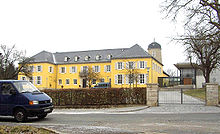
Villa Sauckel

View over the roofs of Weimar to the town church of St. Peter and Paul (Herderkirche), in the background the Jakobskirchturm (photo from about 1963)
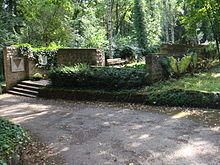
VdN-Honorary Grove for surviving victims of fascism
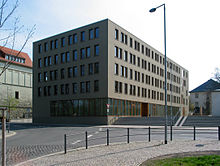
Municipality in the Schwanseestraße
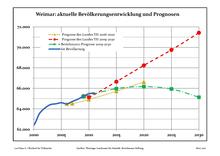
Population development (as of the end of 2017) and forecasts

Population development of Weimar from 1779 to 2016
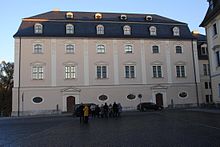
Anna Amalia Library 2015

World Heritage emblem, since 1996 also in Weimar

Burned down roof truss of the Duchess Anna Amalia Library

81 years later: In Weimar, the original election advertisement "Vote Thälmann" for the KPD candidate for the Reich Presidential Election 1932 can still be read in 2013
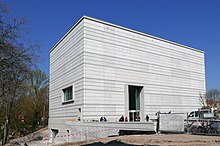
Bauhaus Museum, during the construction phase 2019
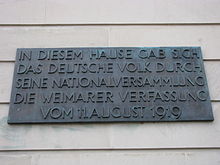
Commemorative plaque to the Weimar National Assembly at the Great House of the German National Theatre
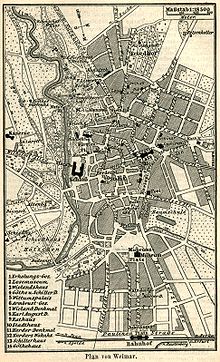
City map of Weimar (1894)
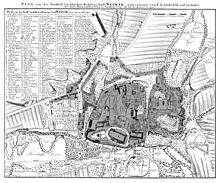
City map of Weimar by Franz Ludwig Güssefeld, 1784
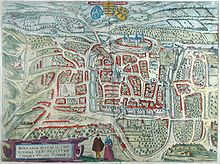
City map of Weimar by Johannes Wolf, 1569
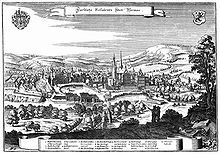
Weimar around 1650
Culture
→ Main article: List of cultural monuments in Weimar
Events
- Weimar Onion Market: Every year on the second weekend in October, the Weimar Onion Market takes place, with traditions dating back to 1653. The onion market extends over the entire old town area and attracts up to 350,000 visitors every year. In addition to the stalls, stages with music and performances provide entertainment.
- Weimar Rendezvous with History: Since 2009, the city of Weimar has been organizing a history festival modeled on the Rendez-vous de l'histoire in the twin city of Blois. On a weekend in November, lectures, panel discussions, a film festival and other events take place on a framework theme. The members of the scientific advisory board and the participants in the events generally come from the countries of the Weimar Triangle.
- "Weimar Master Classes" For more than 50 years, the FRANZ LISZT SCHOOL of Music Weimar has offered master classes in the summer. For this purpose, students from all over the world are invited to take lessons in public courses with internationally renowned musicians. The master classes have since developed into a music festival with numerous public concerts.
- "Genius Loci Weimar" is a festival for site-specific developed audiovisual art with a special focus on façade projections. The festival took place for the first time from 10 to 12 August 2012. A production by the Istanbul artist collective NERDWORKING was presented on the facade of the Fürstenhaus in Weimar, now the main building of the Hochschule für Musik "Franz Liszt". The festival is to take place annually.
- The Weimar Spring Days for Contemporary Music take place every year in the week after Easter.
- Kunstfest Weimar: The annual Kunstfest Weimar takes place from the end of August to the beginning of September. The Kunstfest Weimar is Thuringia's largest and an internationally renowned festival for contemporary arts. For the years 2004 to 2013, Nike Wagner was the artistic director of the Kunstfest Weimar, which is largely funded by the Thuringian Ministry of Education, Science and Culture and the City of Weimar. Since 2014, the Kunstfest has been organized by the Deutsches Nationaltheater Weimar. The artistic director is Christian Holtzhauer.
- "Yiddish Summer Weimar" is an annual international course for Klezmer music and also a music festival of the Other Music Academy. The YSW is one of the most important klezmer master classes worldwide. Founder and director of the Yiddish Summer is the musicologist and musician Dr. Alan Bern. The Yiddish Summer gave rise to the project The Other Europeans, which deals with the connection between Lautari and Klezmer music, and in 2012 to the documentary film "The Broken Sound" by 1Meter60Film.
- "Bachbiennale:" Festival for baroque music and historical performance practice. Since 2012, the Bachbiennale has been expanded to include a children's music festival, the only German baroque music festival for children.
- Every summer, the cultural institutions in Weimar and the Weimarer Land region are open until well after midnight for the Long Night of Museums. Those interested can visit museums, galleries, archives and churches, take part in guided tours and listen to concerts and lectures.
- Cabaret Festival: Since 2004, a six-week cabaret festival has been held every year from May to June on Beethovenplatz in Weimar. In the "Köstritzer Spiegelzelt", erected for this purpose on the meadow, artists from various countries present a programme of music, theatre and cabaret. For the first time in 2010, the audience prize Marlene was awarded at the end of the festival. 35 artists were available for selection in 40 performances. The winner was the trio Malediva.
- Fête de la Musique: On 21 June each year, Weimar takes part in the international Fête de la Musique.
- International Student backup festival
- Classical open-air concert: At the beginning of July each year, the Weimarhallenpark is the venue for a classical open-air concert by the Staatskapelle Weimar. The theme of the event refers to the music of a particular nation (2007: "A Hungarian Night", 2008: "A French Night", 2009: "An American Night"). The musicians play on a floating stage on the pond, while the up to 3000 spectators take their seats on terraces and meadows of the illuminated park.
- Every year on December 10, the International Human Rights Day proclaimed by the United Nations, the City of Weimar awards the Human Rights Prize of the City of Weimar to individuals, groups or organizations whose work promotes more humanity and tolerance between people and peoples.
- The Weimar Prize is an award that has been presented by the city of Weimar since 1990. It is awarded to individuals or "several persons involved in a work who have rendered outstanding services to the cultural reputation of the city of Weimar.
- To mark Goethe's birthday on August 28, the Klassik Stiftung Weimar is organizing various annual activities and artistic interventions. A wine festival is held in front of Goethe's residence.
- Since 2011, the Herder Prize has been awarded on the occasion of Herder's birthday on 25 August.
- Since 1994, the Weimar Speeches have usually taken place in March of each year at the National Theater.
Cultural Centers
- Neue Weimarhalle, built in 1999 as the successor to the Weimarhalle, which was built in 1932 and demolished in 1997, "is one of the most beautiful event and congress halls in Europe" - MDR television broadcast an extensive documentary about the building and its history on 1 December 2013
- ACC Galerie Weimar - Autonomes CulturCentrum - with gallery for contemporary art, events and a restaurant/café house
- C-Keller & Galerie, Markt 21 - Café, Bar, Art Gallery, Event Venue
- E-Werk Weimar with tram depot
- Gaswerk - project workshop and event venue
- Gerber 1 and Gerber 3 - House for Socioculture
- Mon Ami - Youth and Cultural Centre
- Studentenclub Schützengasse - Student club (closed)
performing arts
National Theatre
The German National Theatre with the Staatskapelle Weimar is Weimar's most important theatre company. It is a dual institution consisting of the stage company Deutsches Nationaltheater and the orchestra Staatskapelle Weimar.
Song
The Schola Cantorum Weimar is the largest children's and youth choir in Thuringia.
Cinemas
Weimar has four movie theaters, the Cinestar in Schützengasse, the independent Lichthaus Kino, the Kommunale Kino in the mon ami cultural center and the CineStar in the Atrium on Friedensstrasse.
Buildings
Castles and palaces
Weimar has had a city palace since the Middle Ages, which has been renovated several times. The Wittumspalais, on the other hand, where Anna Amalia spent her last years, dates from the Weimar Classic period. Belvedere Palace and Park, located outside the city centre, were originally the summer residence of the Weimar princes. Tiefurt Palace and Park were of particular importance as Anna Amalia's favourite residence and a meeting place for her literary and musical circle. Ettersburg Palace and Park also had a similar function at this time and today belong to the Weimar Classic Foundation.
See also: Red Castle
Churches
→ Main article: List of churches in Weimar
Weimar's largest church is the Stadtkirche St. Peter und Paul, which was essentially built around 1500. It is also known as the Herderkirche; this name goes back to the work of the theologian and philosopher Johann Gottfried Herder at the time of the Weimar Classicism. The altarpiece was created by Lucas Cranach the Elder and the Younger.
The baroque Jakobskirche, the former court church, is the wedding church of Johann Wolfgang Goethe. The graves of several famous personalities can be seen in its churchyard.
The Catholic Church of the Sacred Heart was built between 1889 and 1891 according to plans by the architect Max Meckel in the style of historicism. In its mixture of neo-Gothic and neo-Renaissance, it is reminiscent of the Florence Cathedral that served as a model.
The Kreuzkirche was originally built in 1899 as the Church of Saint Michael and All Angels for Weimar's then Anglican congregation in the style of late Anglican Gothic. When the congregation disbanded from 1914 onwards (as its mostly English members were considered wartime enemies of Germany and left the country), the church lost its purpose and stood empty. In 1927, Weimar's city church community acquired the sacred building and rededicated it as the Kreuzkirche in 1928. In 1962 it received bells from Apolda, and since 1989 there has been a Schuke organ. More recently, it has been extensively renovated.
The district Gelmeroda has a village church, which is nationally known as Feininger church and motorway church.
See also: List of organs in the district of Weimarer Land and in the city of Weimar and List of bells in the district of Weimarer Land and in Weimar
Other buildings
- Weimar City Hall
- Weimar town house
- Renaissance buildings on the east side of the market, including the Cranach House
- Geleitschenke, historical inn and one of the most beautiful half-timbered houses in Weimar
- Liszt House
- Bach House Weimar
- the Altenburg, once home of Franz Liszt
- Kirms-Krackow House
- Goethe's residence with Goethe National Museum
- Schiller's residence with Schiller Museum
- Goethe and Schiller Monument
- Jacob's cemetery Weimar with the cash vault
- Park on the Ilm with Goethe's Garden House, Roman House and Park Cave
- Historical cemetery with princely crypt and Russian Orthodox burial chapel
- Arts and crafts school building (workshop building of the former State Bauhaus in Weimar)
- Art school building (today the main building of the Bauhaus University Weimar)
- Villa Dürckheim, built in 1912/13 by Henry van de Velde
- Show house "Am Horn
- House High Poplars
- Café Resi, the Residenz-Café, Weimar's oldest coffee house, centrally located between the market and the city palace.
- the former Gauforum Weimar
- Capella "Vox coelestis" (built in 1899, Ehringsdorf cemetery)
- Fountain in Weimar
- Hafis Goethe Monument
- Home Rich Table
- Lenin light box in the foyer of the La Redoute theatre hall, former seat of the Soviet military. The light box is a copy of a leaded glass window by Alexander Leonidovich Korolev.
· 
Goethe's residence at the Frauenplan
· 
Schiller's residence on Schillerstrasse
· 
Foundation walls of the Bach House, where the composer Johann Sebastian Bach lived
· .jpg)
New Museum Weimar
Memorials
- Albert Schweitzer Memorial and Meeting Place, Museum im Musäushaus
- Buchenwald Concentration Camp Memorial and Buchenwald Special Camp No. 2
- Ernst Thälmann Monument on Buchenwald Square
- Monument of the March Fallen at the Historical Cemetery Weimar
- Memorial at the main cemetery for the victims of the American bombing raids in 1945
- Memorial stone in the Webicht for 149 prisoners murdered by the Gestapo
- Memorial plaque on the house of the Jewish families Ortweiler and Appel Am Brühl 6
- Jewish cemetery in the Leibnizallee
- Death march stele at the corner of Ettersburger/Rießnerstraße
Museums
Art museums and galleries
Contemporary art is exhibited at the Neues Museum Weimar, an institution of the Klassik Stiftung Weimar. Regular exhibitions are shown at the Galerie Eigenheim, the ACC Galerie Weimar and the municipal art gallery Harry Graf Kessler.
The Bauhaus Museum contains exhibits from the Bauhaus art school founded in Weimar in 1919, including works by Walter Gropius and Johannes Itten. In 2019, the new Bauhaus Museum was opened adjacent to the Neue Weimarhalle and the Gauforum, replacing the temporary building on Theaterplatz.
Painting from the 16th to the 19th century is housed in the museum in Weimar's city palace.
History Museums
The Thuringian State Office for the Preservation of Archaeological Monuments maintains the Museum for Prehistory and Early History of Thuringia in Weimar.
The history of the city itself is presented in the city museum, which is located in the Bertuchhaus. The exhibition begins with traces of the earliest settlement and focuses on the work of Johann Sebastian Bach and Friedrich Justin Bertuch in Weimar, as well as the National Assembly of 1919 and the Weimar Republic.
The House of the Weimar Republic on Theaterplatz commemorates the adoption of the Weimar Imperial Constitution in 1919.
The Weimarhaus, a private "history experience museum", shows important historical events in the form of entertaining dioramas.
Other museums
- In the German Bee Museum all aspects of beekeeping can be viewed.
- The Weimar Railway Museum is home to Thuringia's largest collection of historic locomotives.
- The Ginkgo Museum is the only one of its kind dealing with ginkgo plants.
- The small umbrella museum of the Pennewitz family is located in the Rittergasse.
- The smallest museum in Weimar is dedicated to Marie Seebach in Tiefurter Allee. It served as a model for Giuseppe Verdi's Casa Verdi in Milan.
Media holdings
Archives
- Thuringian State Archives with the Thuringian Main State Archives
- Goethe and Schiller Archive
- City Archive Weimar
- Nietzsche Archive
- Fürnberg Archive
- Thuringian State Music Archive and University Archive
Libraries
- Duchess Anna Amalia Library with Military Library
- University Library (UB) of the Bauhaus University
- Library of the University of Music
- Library of the Buchenwald Memorial
- City Library
- Green League Environmental Library
- Catholic Public Library
- DDR bookshop Taubach
Sports
Associations
The most famous club in the city is the football club SC 1903 Weimar, formerly Motor Weimar. It has played in GDR times mostly in the GDR league (2nd league), briefly also in the Oberliga (1st league), is currently in the Thüringenliga. Home games are played in the football-only stadium Am Lindenberg, which is located on the arterial road towards Jena.
Weimar successes, with victories at state, national and GDR level or membership of the highest playing class, occurred in a surprising number of sports. One example is white-water canoeing at KGC 66 Weimar, which Weimar athletes had dominated for a time in the GDR. Weimar also has teams or individual athletes at a good amateur level in hockey, tennis, volleyball, chess, boxing, fencing, judo, basketball, gymnastics, table tennis, lifeguard swimming and old men's football.
Sports facilities
The city's largest concentration of sports facilities is located between the center and Weimar-West, consisting of the Schwanseebad, Johannes swimming pool, Wimaria Stadium, tennis courts and three-field hall. In addition, there are other facilities such as the Falkenburg, a hard soccer field including a three-field hall, the boathouse as a canoeing center on the Ilm, and the school sports halls that are open to clubs from the afternoon.
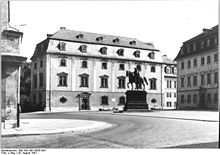
Duchess Anna Amalia Library 1991

Duchess Anna Amalia Library

Buchenwald Memorial

The Gelmeroda church as a light sculpture
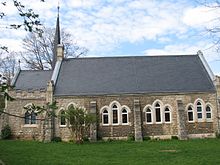
Cross Church Weimar
.jpg)
Church of the Sacred Heart (Weimar)

City church St. Peter and Paul, also known as Herder church

Weimar city palace with palace tower
.jpg)
Cultural centre mon ami at Goetheplatz
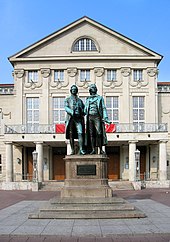
German National Theatre Weimar with Goethe and Schiller Monument

Neptune in front of the Weimar town hall
Search within the encyclopedia